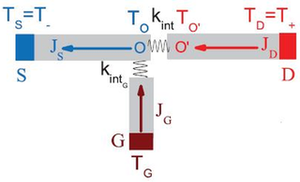November 2, 2007 feature
'Phononic Computer' Could Process Information with Heat

Most computers today use electrons to carry information, while theoretical optical computers use photons. Recently, physicists from Singapore have proposed a third type of computer: a “phononic computer,” which would use heat, carried by phonons, to perform operations similar to its electronic counterpart.
“Heat is very abundant and very often it is regarded as useless and harmful for information processing,” Professor Baowen Li of the National University of Singapore told PhysOrg.com. “The merit of our paper is that we demonstrate that, in addition to the existing electrons and photons, the phonons can also perform a similar function. This provides an alternative way for information processing. Moreover, the heat can be harnessed to use.”
Li and co-author Lei Wang from the NUS have demonstrated how to make thermal logic gates for possible use in future phononic computers, with their results published in a recent issue of Physical Review Letters.
Logic gates, one of the basic elements of computers, perform an operation on one or more logic inputs to produce a single logic output. In electronic logic gates, the inputs and outputs are represented by different voltages. However, in a thermal logic gate, the inputs and outputs are represented by different temperatures.
The key element of the logic gate is the thermal transistor (which was invented by Li’s group last year), which works similar to how a field-effect transistor controls electric current. The thermal transistor is composed of two terminals that are weakly coupled, plus a third control terminal.
“Like all other theoretical modeling, we use heat bath to produce heat, which is a kind of random atomic or molecular motion,” Li explained. “To conduct heat, you don't need too much external power. Any temperature difference will lead to heat conduction.”
In the researchers’ model, heat is conducted by lattice vibration. When the vibration spectra of the two terminals are combined, their overlap determines the heat current. For example, when the two spectra overlap, the heat can easily travel between the terminals, representing the “on” state. When the vibration spectra do not overlap, very little heat (or no heat) passes through, representing the “off” state. The “negative differential thermal resistance” (NDTR) that occurs due to the match/mismatch of vibrational spectra of the terminals’ interface particles, makes the “on” and “off” states both stable, making the thermal logic operations possible.
“Like we explain in our Physical Review Letters article, all these logic gate functions can be achieved only when the system has the so-called negative or super response, by which we mean that the large temperature difference (change) will induce the small heat current,” Li said. “This is the so-called ‘negative differential thermal resistance.’” The NDTR phenomenon was also discovered by Li’s group in 2006.
The researchers demonstrate how combining thermal transistors can be used to build different thermal logic gates, such as a signal repeater. A signal repeater “digitizes” the heat input, so that when the temperature is higher or lower than a critical value, the output is either “on” or “off,” but not in between. By connecting a few thermal transistors in series, the researchers achieved a nearly ideal repeater. Besides signal repeaters, they also demonstrated a NOT gate, which reverses the input signal, and an AND/OR gate, made from the same thermal transistor model.
While the current model simply shows the feasibility of thermal logic gates, Wang and Li predict that an experimental realization of the devices in nanoscale systems may not be too far off. They point out that another thermal device, the solid-state thermal rectifier, was experimentally demonstrated in 2006, just a few years after the proposed theoretical model.
“One advantage of a phononic computer might be that we don't need to consume a lot of electricity,” Li said. “We may use the redundant heat produced by electronic devices or provided by Mother Nature to do useful work. Another advantage is that, one day, human beings can control and use heat wisely so that we may save a lot of energy—which is a big issue nowadays.”
More information: Wang, Lei, and Li, Baowen. “Thermal Logic Gates: Computation with Phonons.” Physical Review Letters 99, 177208 (2007).
Copyright 2007 PhysOrg.com.
All rights reserved. This material may not be published, broadcast, rewritten or redistributed in whole or part without the express written permission of PhysOrg.com.





















